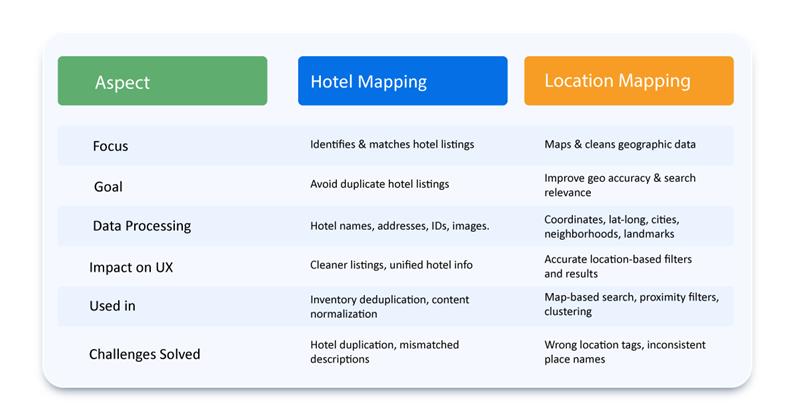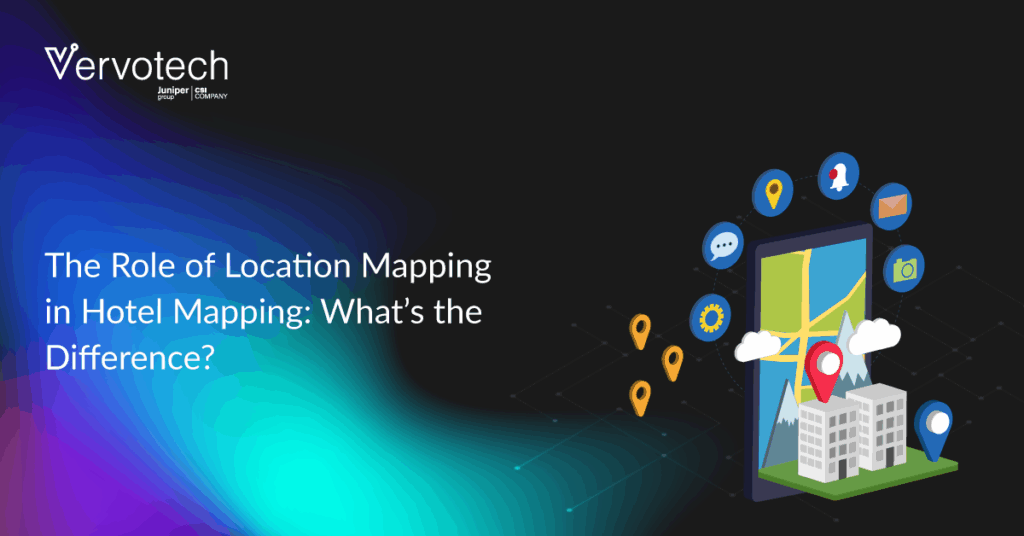Is your travel inventory clean, or are you unknowingly offering the same hotel twice under two different names?
Your travel platform’s data quality directly impacts its revenue, user trust, and brand credibility. Poorly mapped hotels or mismatched locations can lead to duplicate listings, booking errors, and confused travelers.
Those are the kind of issues that hotel and location mapping solve—but in different ways. While “hotel mapping” and “location mapping” often get mentioned in the same breath, they serve distinct purposes.
Understanding these two concepts can help OTAs, and wholesalers avoid duplication, deliver accurate content, and offer smoother booking experiences.
This blog explains what each one does, how they work together, and where their roles differ in managing hotel inventory and enhancing traveler experiences. Let’s break it down.
What is Hotel Mapping?
Hotel mapping focuses on identifying and connecting identical hotel properties that appear across different sources, even if the names, addresses, or IDs vary. For example, a hotel listed as The Grand Hyatt NYC on one supplier and Grand Hyatt New York on another should be recognized as the same hotel in your system.
Hotel mapping helps eliminate duplicates in your listings, ensure accurate content like images, descriptions, and amenities, and maintain a consistent hotel identity across channels.
It’s essential for businesses working with multiple suppliers or global inventories. Location mapping, on the other hand, focuses on ensuring precise location in hotel listings.
What is Location Mapping?
Location mapping deals with organizing and matching geographical data to ensure that every hotel, landmark, or area is accurately placed. It’s less about the property itself and more about where that property is. For instance, if one supplier lists a hotel as being in “Manhattan” and another in “New York City,” location mapping ensures both point to the same region on the map. Some of its benefits include:
- Improving search filters for users (e.g., hotels in Paris near the Eiffel Tower)
- Supporting location-based recommendations
- Enabling proximity-based search or clustering for user interfaces
While both hotel mapping & location mapping serve different purposes, they are related in a few aspects. Let’s learn how.
How Are Location Mapping & Hotel Mapping Related?
While hotel mapping identifies and matches hotel entities, location mapping aligns those hotels to their correct geographic coordinates or regions. Together, they form the backbone of clean, searchable travel data.
Think of it this way: hotel mapping ensures what hotel is being shown, and location mapping ensures where it is. Both need to work hand-in-hand to offer accurate search results and booking options. When one fails, users may see duplicates, wrong hotels in the wrong neighborhoods, or misleading search filters.
Hotel Mapping vs. Location Mapping: Key Differences

Conclusion
Clean data drives confidence for both the user and the platform. Hotel mapping and location mapping serve different but equally critical purposes in maintaining data quality in travel platforms. While hotel mapping ensures no duplicate or mismatched properties slip through, location mapping guarantees travelers are searching and booking in the right areas. To deliver accurate, consistent, and reliable travel content at scale, both need to be part of your data stack. Ignoring one compromises the performance of the other.
As mapping data continues to improve with platforms like OSM and other geospatial tools, the travel industry is well-positioned to offer travelers not just a place to stay- but the right place to stay.







